Chapter 2: Understanding C-UAS Purpose and Process
C. Carter
Introduction
Drone technologies are evolving rapidly and, not surprisingly, counter-drone technologies are as well (Cole, 2019). The threat of UAS used by insurgents for surveillance or to delivery of hazardous payloads has increase
Each industrial revolution has included changes in the industrialization of warfare. An industrial revolution increases the killing power, mobility, and production of weapons along with the growing advancement of technology and population. The Fourth Industrial Revolution has not been different then predecessors, it continues to bring dramatic changes to how war is waged. The addition of space and cyber as domains of battle has made our world more complex than ever before. Unmanned Aircraft Systems (UAS) are unique, they can be used in all war domains (air, land, sea, space, and cyber) in single or multiplex scenarios. The threat of UAS is the strongest multi-domain battlefield weapon of our time. Countering this emerging threat requires strength in understanding how UAS is used for good and evil, the growing technological advancements of UAS, and the ability to predict how UAS will evolve in the future. The global market for C-UAS is to two billion dollars by 2024 (Global Aerospace Techology Network, 2019).
In terms of complexity of C-UAS, the size of UAS needs to be taken into consideration. Small UAS (sUAS) can be used in all war and domestic domains. The sUAS, can carry a deadly payload, be used to identify targets, confuse systems, and send critical target information. sUAS are ideal for asymmetric warfare with the characteristics of being stealth, pervading, and inexpensive. The complexity of sUAS as a multi-vector threat are endless, creating the largest challenge in the Counter Unmanned Aircraft Systems (C-UAS) industry. Larger UAS, while limited in threat vectors, has proven to be an asset in battle. Large UAS can also carry a deadly payload, be used to identify targets, confuse systems, and send critical information. However, they are predictable in execution of these capabilities. UAS can also be segmented into private, commercial, and military. These verticals have similarities and differences, however overall the common characteristic is they are a valid threat vector.
Figure 2-1: Flock of Drones in the Air
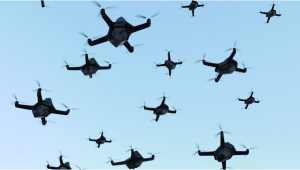
Source: (Ruff, 2017)
Driving forces for increasing the demand for C-UAS
UAS can be beneficial when used for good. However, to understand the need for C-UAS, the level of threat of UAS poses has to be considered. Low cost has makes UAS widely attainable at all levels of the population. The evolving risks of UAS used for evil, in the military theater and homeland. Outside the military theater, UAS can be used for attacks against critical infrastructure, terroristic attacks and target intelligence collection, and assist members of organized crime. Inside the military theater, small commercial UAS can transport critical surveillance data and explosives for a terrorist group. As far back as 2014, Daesh militants use DJI quadrotors for reconnaissance against Kurdish fighters (Defence iQ, 2019).
The traditional methods of interdiction serve as the base for the evolution of disruptive technologies needed to build an equal, eventually superior, countermeasure to rogue UAS. Currently when a threating UAS situation can be mitigated, the threat has been met with defense measures verses offensive countermeasures. Viable threats and attacks of UAS has limited the C-UAS space to just interception and detection of all sizes of UAS (Michel A. H., 2019). Predicting the threat of UAS is far from perfection, with the gap growing. Offensive security measures are ideal to have in place to be consistently successful in defeating threats. The progression of C-UAS technologies has the challenge of keeping up with the evolution of UAS, defensively and offensively.
C-UAS and the Fourth Industrial Revolution
The Fourth Industrial Revolution is characterized by an unprecedented speed, scale and scope of technological change, with governments around the world struggling to adapt their approaches to policy and regulation in the face of these transformations (World Economic Forum, 2018). The Fourth Industrial Revolution has not been different then predecessors, it continues to bring dramatic changes to how war is waged. The addition of space and cyber as domains of battle has made our world more complex than ever before. UAS are the airspace Unmanned Aircraft Systems (UAS) are unique, they can be used in all war domains (air, land, sea, space, and cyber) in single or multiplex scenarios. The threat of UAS is the strongest multi-domain battlefield weapon of our time. Countering this emerging threat requires strength in understanding how UAS is used for good and evil, the growing technological advancements of UAS, and the ability to predict how UAS will evolve in the future. The global market for C-UAS is to two billion dollars by 2024 (Global Aerospace Techology Network, 2019).
In December 2018, a commercial UAS became a threat at Gatwick Airport. With over sixty reports of UAS sightings near the runway, airplanes (a prior industrial revolution invention) were under possible attack from its next evolutionary competitor. The majority of modern airports are not prepared to respond to an UAS attack, nor prior to this global impacting incident, had not thought about UAS as a threat. Ben Marcus, Chairman of AirMap, recommends combining to an Unmanned Traffic Management (UTM) system with a C-UAS system to complete the airspace operation environment (Marcus, 2019). The integrated system, will supply information related to any aircraft detected by C-UAS is exchanged with the UTM system and remotely identified as either collaborative (registered) or non-collaborative, requiring intervention (Marcus, 2019). Gatwick is one event of an airport facing the threat of a rogue drone. Events of UAS threat have occurred globally including New York and Dubai. While UAS is widely recognized as part of the fourth industrial revolution, C-UAS needs to be acknowledged at all levels as part of the revolution in order to evolve at the rapid rate necessary to match the advancements of UAS. The use of one vector of C-UAS will not solve an issue, other disruptive technologies will have to be combined to thwart this fourth industrial revolution.
Figure 2-2: UTM and C-UAS

Source: (Image: AirMap) (Marcus, 2019)
Disruptive technologies that will innovate the future of C-UAS
A disruptive technology is one that provides a non- typical technological solution to simplify our everyday life. UAS can be considered one of the ultimate disruptive technologies of our time. UAS has been the most dynamic growth sector of the global aerospace industry in the last one decade. The present day UAS is an amalgamation of advances made in different domains of science and technology, such as composite materials, aerodynamics, communication systems, radars, propulsion systems, precision navigation systems, sensors, digital signal processing and so on (Sharma, 2017). These characteristics are true for C-UAS. When combining C-UAS with artificial intelligence (another disruptive technology), the ability to extend flights, identify and remember objects, and understand and collect intelligence.
The difficultly of tasks for C-UAS grows almost daily as technology continues to evolve at a rapid pace. At the time of this writing, the effort to keep ahead of the curve at times is overwhelming.
Proven, is the instability of using one type of technology for countering UAS. The traditional method of high-performance Radio Frequency (RF) is a thing of the past. Deaf drones or drones that do not follow the pattern of library of sounds for acoustic sensors demonstrate RF is not effective as a countering method. Another example is the combination of Electro-Optical systems (EO) with Infrared Sensor (IR) cannot successfully distinguish a bird from an airplane in broad daylight (Michel A. H., 2019). Thus, causing a great deal of false positives, rendering the detection unreliable and unusable. Detection technology must evolve to be able to properly identify the target UAS despite weather, time of day, and/or sound pollution. For example, at a large sporting event, the airspace may be crowded with legitimate aerial cinematography drones that do not pose a security risk (Michel A. H., 2019). In the military theater, C-UAS system that cannot tell the difference between allied and adversary unmanned aircraft could accidentally shoot down friendly drones (Michel A. H., 2019) Therefore, the C-UAS system will need to be able to read intent of the incoming UAS, forcing the need for the disruptive technology of Artificial Intelligence (AI).
Applying countermeasures also comes with legal implications. In the theater, peacetime verses wartime uses of C-UAS different policies apply by country law. The method of C-UAS could also be a factor in legality. If C-UAS is used as a matter of public safety versus military engagement. Could innocent human life being at risk outweigh a defensive measure?
The Need for Innovation of C-UAS
In 2016, commercial UAS new developments included waterproofing, robotic arms, and functionality to remotely control the UAS from mobile device. There was the introduction of a pocket size drone that could identify an object, remember it for tracking at a later time. Today. commercial UAS technology has developed to include sense and avoid capability, artificial intelligence to learn patterns from collected data and run pre-programmed flight path. In 2020, commercial drones will have sharper picture/video quality, greater storage, longer flight time, all packed into a device that is smaller than an iPhone.
Military C-UAS has traditionally focused on RF and GPS. Future military C-UAS will need to address speed, ease of installation, precision detection, ease of mobility and versatility (large/small UAS, swarms, etc.) Military C-UAS have focused on defending against large UAS verses sUAS.
With the rapid innovation and use of commercial UAS, C-UAS needs to not only match but exceed functionality to be a successful combatant. The ideal future C-UAS will use artificial intelligence (AI) algorithms that automate the detection, identification, locating, and tracking of drones with minimal false detections, and directed energy weapons that can mitigate multiple drones quickly and/or simultaneously (Global Aerospace Techology Network, 2019).
There is a need integrate multiple technologies to combat the multiply vectors of attack; for example, anti-swarm, complex tracking, signal jamming, ability to be cellular controlled and operate in a congested air traffic area. The commercial user community would like the future C-UAS have functionality to locate drone operators and operate on open architecture software that allows for integration into existing security systems (Global Aerospace Technology Network, 2019).
Figure 2-3: Black Sage UASX-L3 Automatic Drone Disruptor

Source: (Black Sage, n.d.)
The Black Sage C-UAS, UASX-L3 Automatic Drone Disruptor, is leading the market with functionality. The UASX-L3 detects, tracks, identifies and disrupts UAVs using a new type of doppler Compact Surveillance Radar (CSR), artificial intelligence and long-range video tracking and RF jamming components (Black Sage, n.d.). Black Sage was recently acquired by Acorn Growth Companies, a private equity firm. This could impact the advancement and direction of Black Sage. Other C-UAS start-up companies in Silicon Valley have felt backlash in the form of protests and code deletion, based on political and ethical beliefs of the employees.
UAS and C-UAS Qualify as the New Global Arms Race
At the end of World War II marked the beginning of the arms race between the U.S., Russia, and respected allies to build the best nuclear warfare program in the world. Starting in 1987, countries came together and through a series of treaties and initiatives the global superpowers and their allies agreed to take steps to limit and stop the creation of nuclear missiles and cap military wartime inventory. For thirteen years, Russia and the U.S. did not change their approach. Suspicions let to cracks in agreements, and slowly the effort to control arms has crumbled. The new arms race is not between two nation-states, it is become a global race among larger players that threaten not only each other but are all face a common unpredictable threat of terrorism.
Russia has developed a comprehensive strategy for using UAS in warfare. The Russian military perceives this strategic approach foremost as “no-contact warfare”, described as a war where Russian military can defeat a hostile state without the engagement of regular Russian forces (Sharma, 2017). February 2019, the anti-drone forces development by Russia released their first mobile units, part of the radio engineering forces armed with the “Kasta 2-2″ radar and an automated air defense control system (ACS) (Bendett, 2019). Kasta 2-2 uses landscape features combined with the ability to monitor objects that fly at a low altitude with little false positives.
Russia’s “Silok” C-UAS can debilitate the control channels, communications, and telemetry of sUAS. Another Russian C-UAS solution, created by the Sozvezdiye Group, is a radio electronic system based on artificial intelligence to fight illegal drones (Bendett, 2019). This C-UAS learns10,000-20,000 standard situations to produce selective impacts on objects. Enabling this C-UAS to make ‘friend or foe’ decisions based on an array of signs, situations and the object’s behavioral characteristics (Bendett, 2019).
Currently the U.S. Air Force is embarking on a year of testing and training of High Energy Laser Weapon Systems (HELWS) supplied by Raytheon. According to Raytheon’s website, HELWS is an open architecture laser weapon system that can work on land, in the air and at sea, providing 360-degree coverage (Raytheon, 2019). In addition, the U.S. Air Force is testing Lockheed Martin’s Advanced Test High Energy Asset (ATHENA), an anti-drone laser. ATHENA has the capability to shoot down multiple fixed wing and rotary drones. Raytheon’s defense customers are “likening drones to the improvised explosive device (IED) situation 20 years ago, when we saw an adversary take a readily available technology and weaponize it in a low-cost way,” says Todd Probert, vice president of Raytheon Intelligence, Information, and Services (Dulles, Virginia) (Cole, 2019).
Figure 2-4: Russia’s Kasta 2-2
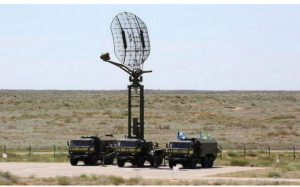
Source: (Bendett, 2019)
Figure 2-5: U.S. High Energy Laser Weapon Systems (HELWS)
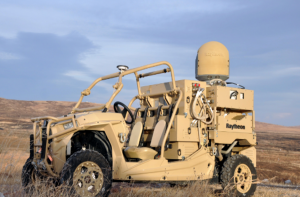
Source: (Raytheon, 2019)
The Italian company, IDA Ingegneria Dei Sistemi, has created a military grade system, NO-DRONE. The system has been tested in China and in North America. NO-DRONE has been released in North America by a third party, 34 North Drones, for all government and civilian protection applications. NO-DRONE uses EMP, powerful multiband jamming, GPS spoofing or live fire systems to disable, redirect or destroy threats (UAS Weekly, 2019) Italy is not the only smaller country exploring C-UAS. Singapore’s ST Engineering Electronics Ltd. sells a 6.6-pound radar gun powered by a 24-pound battery backpack that can jam a drone’s GPS signal and disrupt the radio link to its operator (Wall, 2019). Diehl Defense has a fire electronic laser that has a range of more than 0.6 miles and also comes in a smaller, civil version with about half that range (Wall, 2019).
Figure 2–6: IDS NO-DRONE
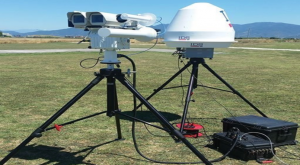
Source: (UAS Weekly, 2019)
China Central Television reported in September 2019, China Aerospace Science and Industry Corporation (CASIC) has developed a counter-drone system consisting of multiple weapons and equipment, including land-based rockets and drone-hunting drones that can shoot huge webs and vehicle-based detection devices (Chan, 2019). In 2018, at the China Airshow CASIC showcased a vehicle-based laser weapon called LW-30, which could use a directional-emission high-energy laser to quickly intercept many kinds of aerial targets (Chan, 2019). Early in 2018, in Abu Dhabi, the Chinese “Silent Hunter”, the portable drone killing laser, can shoot from 2.3 miles (Military Aerospace Electronics, 2018). Chinese state-owned Poly Technologies Inc. has a truck mounted drone downing laser with range of up to 4 kilometers.
Figure 2-7: China’s LW-30
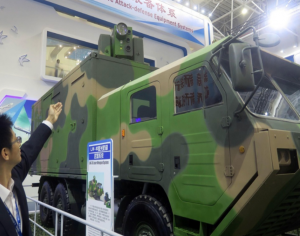
Source: (Chan, 2019)
Conclusions
The rapidly growing industry of C-UAS is a needed force to combat rogue UAS activity. C-UAS are used to locate, track and neutralize unwelcomed UAS. The growing need for C-UAS spans from the commercial to the military space, since the threat of unidentified UAS in the civil and military theater increases. The is not an international standard for the design of C-UAS and not all C-UAS systems work as advertised. Along with evolving C-UAS technology, global standards and policies will need to be developed. But make no bones about it, the need is being addressed. From jamming rifles to ground installations that fire nets, a new report lays out the expansive Wild West of anti-drone tech entitled: “Report on 537 Anti-Drone Systems Shows How Wild the Market Has Become.” (Gault, 2019) Bard University also has addressed the Counter Drone Systems 2nd Edition. (Michel A. H., 2019)[1]
References
Bendett, S. (2019). Updates on Russian CUAS Capabilities and Rising SUAS Capabilities. Arlington: CNA Analysis and Solutions.
Black Sage. (n.d.). Black Sage Technology C-UAS . Retrieved from Black Sage Technology : https://www.blacksagetech.com
Chan, D. (2019, September 16). Asia Times. Retrieved from Asia Times China Digest: https://www.asiatimes.com/2019/09/article/china-has-systems-to-counter-drone-attacks-source/
Cole, S. (2019, November 16). Military Embedded Systems. Retrieved from Military Embedded Systems Unmanned Systems: http://mil-embedded.com/articles/counter-drone-technologies-are-evolving-to-counter-countermeasures/
Defence iQ. (2019). Counter UAS Efforts. Retrieved from Defence iQ: https://www.defenceiq.com/events-counteruas/downloads/counter-uas-efforts-an-interactive-timeline?-ty-m
Gault, M. (2019, December 13). Report-on-537-anti-drone-systems-shows-how-wild-the-market-has-become. Retrieved from www.vice.com: https://www.vice.com/en_us/article/z3bb59/report-on-537-anti-drone-systems-shows-how-wild-the-market-has-become
Global Aerospace Techology Network. (2019, October 25). Unmanned Intelligent Aerospace. Retrieved from Intelligent Aerospace: https://www.intelligent-aerospace.com/unmanned/article/14069350/counter-uav-uas-drone-market
Keller, J. (2018, September 6). Military Aerospace Electronics Computers. Retrieved from Military Aerospace Electronics: https://www.militaryaerospace.com/computers/article/16726639/three-us-companies-takeon-challenges-of-nextgeneration-electrooptical-and-radiofrequency-sensors
Lei, Z. (2019, November 18). China Daily. Retrieved from China Daily Global: http://www.chinadaily.com.cn/global/2019-11/18/content_37523716.htm
Marcus, B. (2019, January 23). World Economic Forum. Retrieved from World Economic Forum Emerging Technologies: https://www.weforum.org/agenda/2019/01/3-steps-to-prevent-the-next-gatwick-incident/
Michel, A. H. (2018, December 3). The Washington Institute. Retrieved from Improving the Quality of U.S. Middle East Policy: https://www.washingtoninstitute.org/policy-analysis/view/counter-drone-capabilities-in-the-middle-east-and-beyond-a-primer
Michel, A. H. (2019, November 10). The Center for the Study of Drone at Bard College. Retrieved from Drone Center Bard College: https://dronecenter.bard.edu/projects/counter-drone-systems-project/counter-drone-systems/
Military Aerospace Electronics. (2018, October 1). Military Aerospace Electronics. Retrieved from Military Aerospace Electronics Unmanned : https://www.militaryaerospace.com/unmanned/article/16707244/china-in-race-for-counterdrone-technology-and-laser-weapons-as-it-tries-to-catch-up-with-us
Raytheon. (2019). Raytheon Laser Solutions. Retrieved from Raytheon: https://www.raytheon.com/capabilities/products/lasers
Ruff, N. (2017, September 1). SIA Technology Insights. Retrieved from Security Industry Association: https://www.securityindustry.org/2017/09/01/drones/
Sharma, M. (2017, August). Centre for Joint Warfare Studies. Retrieved from UNMANNED AIRCRAFT SYSTEMS: A DISRUPTIVE TECHNOLOGY: https://cenjows.gov.in/pdf/synergyarticle/Book_unmaned_aircraft.pdf
UAS Weekly. (2019, November 13). UAS Weekly Counter UAS. Retrieved from UAS Weekly : https://uasweekly.com/2019/11/13/military-grade-no-drone-counter-uas-radar-detection-system-released-for-airports/
Wall, R. (2019, March 3). Wall Street Journal. Retrieved from Wall Street Journal Business: https://www.wsj.com/articles/weapons-makers-declare-war-on-drones-11551627000
World Economic Forum. (2018). Advanced Drone Operations Toolkit: Accelerating the Drone Revolution. Cologny/Geneva: World Economic Forum.
[1] Both Gault & Michel references are based on the same report from Bard University – just with different emphasis.

